April 30, 2020
 by Mark Quadros / April 30, 2020
by Mark Quadros / April 30, 2020

Even if you’ve never heard of the term, it’s likely that you know what an omnichannel supply chain is.
Have you ever been in one of the following situations?
If any of these things have happened to you or would bother you, then deep down, you’ve always known that it could be done better. You just didn’t know what “it” was.
In this article, we’ll introduce you to the world of the omnichannel supply chain, key aspects, give you some comparison analysis to think about, and show you why an omnichannel supply chain has limitless possibilities. By the end, this method will be your new best friend that will help you increase sales.
“Omnichannel” is more than a corporate buzzword. An omnichannel strategy is a new wave of approach to marketing, where the company hyper-optimizes its service to the customer’s needs. They do this with all the resources and channels (such as in-store, online, mobile, etc.) working in sync to create the perfect sales experience.
This level of coordination presents itself mainly in the back-end of a company’s operations, i.e., its warehousing and IT solutions. This is where the omnichannel supply chain comes in.
To clarify, an omnichannel supply chain is a multi-faceted, but coordinated effort to move products from end-to-end with the most efficiency.
This means the purpose of an omnichannel approach is to strike the perfect balance of customer happiness and inventory management. Ultimately, you are aiming to increase profits and sales by creating loyal fans out of your customers with the help of a customer-focused strategy.
This is an omnichannel approach. All sources work in sync to create an easy, seamless experience for the customer.
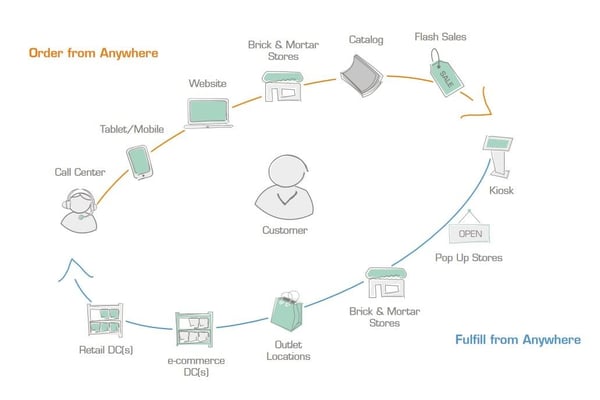
Think about your favorite shoe store for a second. Imagine if you went there, and they had no shoes because all of their stock was used to fulfill online orders. Very disappointing, right? Let’s break this method down through a few examples.
Nailing the perfect shopping experience is hard. How many times have you purchased a product online and yet, kept receiving ads about it on Facebook or elsewhere on the internet?
It’s extremely annoying. This shows that brands have a lot to learn about the omnichannel shopping experience if they can’t even do a simple remarketing cross-reference.
Seventy-one percent of shoppers say they use their mobile devices in-store to make a purchase decision. Yet, the mobile experience still lags behind. According to that same research by Salesforce, the average mobile experience across all stores was rated at just 1.74 out of five.
Can you believe that? And we thought that the new digital normal was already here! How are we still talking about the need for mobile-optimization?
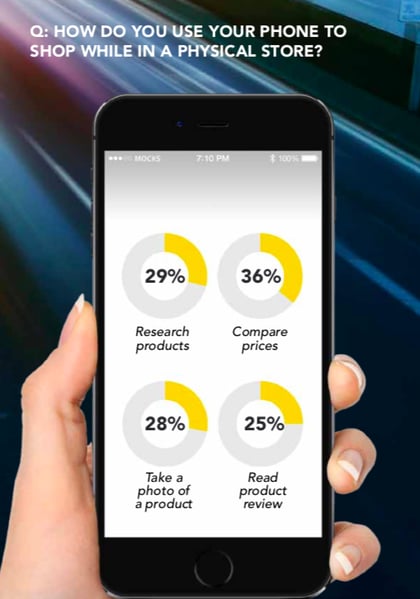
Some brands are catching on. For example, Sephora goes ahead of the mobile experience issues and offers in-store tablets where customers can look up their "Beauty Bag" account while shopping. The tablet also allows them to virtually try on products, add them to their wishlist, and purchase everything on the spot.
Mobile integration is just one of the pillars of the omnichannel experience. A retailer’s return policy can often play a memorable role in a customer’s shopping journey.
Take Nordstrom, for example. Their return policy is arguably one of the most flexible ones in the US market today. There is no return time limit, no receipt required, and no paperwork needed. You can even return online items to any one of their stores or ship them back for free.
The only exception to this is their special occasion dresses. Still, they exemplify the core values of a true omnichannel supply chain: all back-end processes coordinated in the name of making the customer happy.
Alibaba’s Freshippo supermarkets (formerly known as Hema) are utilizing mobile experience, personalized remarketing, digital pickup service, same-location fulfillment center, and much more.
See it for yourself:
Alibaba’s grocery store is all about freshness, quick service, and digitally available information. They have recently added even more features to give customers a wider range of services. These features included takeaway breakfast stations, a tech-driven farmers’ market, and a full-fledged shopping mall.
What’s the difference between omnichannel vs. multichannel supply chains? On the surface, it seems that both are aiming to serve customers from multiple sources, most commonly from online or in-store locations.
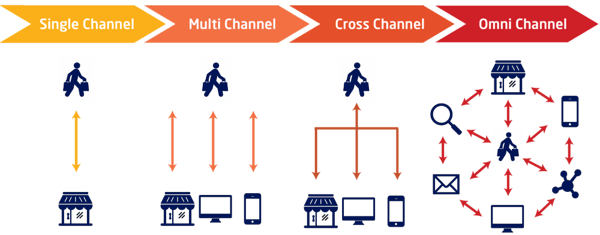
First of all, let’s establish the definition of a multichannel supply chain. It’s a type of supply chain that handles back-end product movement in separate silos; for example, one for mobile, web, in-store, or catalog purchases.
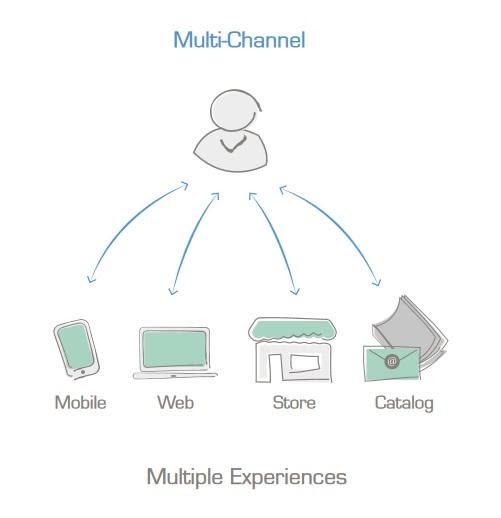
This is a multichannel approach. Several opportunities to purchase, but all purchases are handled differently. It is still used by many multichannel retailers.
Sure, a retailer using the multichannel approach has probably adapted to the bare minimum of today’s B2C digital necessities. They are aware of the importance of having an online store, being mobile-friendly, maybe they even know about e-commerce SEO.
These assets are fairly easy to implement. Switching to an omnichannel approach, however, requires an enormous effort and coordination.
Big brands (and many small brands) that stand out nowadays are the ones that took the leap to a more centralized supply chain management. It takes some serious project planning, a few painful updates to set-in-the-ways suppliers, and not the least, a pretty penny to execute.
| FEATURES | OMNICHANNEL | MULTICHANNEL |
| Front-end and customer service | ||
|
Purchase from multiple sources or channels |
yes |
yes |
|
Purchase items at the same price no matter the channel |
yes |
no |
|
Option to pick-up item in-store |
yes |
no |
|
Return items to any source |
yes |
no |
|
Back-end and marketing |
||
|
|
yes |
no |
|
|
yes |
yes |
|
Channel-specific communication |
yes |
yes |
|
|
yes |
no |
|
|
yes |
no |
Being a customer-first company pays off faster than you think. Companies with a well-defined omnichannel strategy achieve a 91% higher YoY increase in customer retention rate on average compared to organizations without omnichannel programs. They also average a 3% increase in customer lifetime value.
Other advantages are:
Most of the disadvantages of switching to an omnichannel supply chain come from the challenges during the initial stages of the upgrade. In the long-term, these sacrifices will pay off.
If your company is just starting and the budget is low, with an organized approach and automations in place, a multichannel supply chain could still work. However, this option is becoming more and more obsolete as time goes by. Make sure to include the costs of an upgrade in your business plans.
You will see that within the omnichannel approach, most aspects of supply chain optimization will come down to either physical location revamp or the integration of your IT systems.
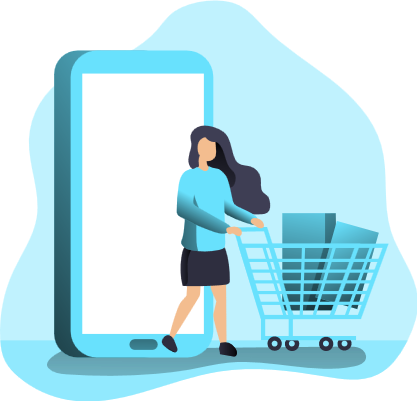
Source: Mark Quadros
In many cases, it will be both. The good news is that these changes are here to reduce your busy work in the long-run and increase your sales.
Today’s customers can be found on a wide variety of online platforms. Based on the previously-noted Salesforce survey, 87% of shoppers begin product searches on digital channels. Companies are expected to follow suit. Being present on social media as an e-commerce company is a must-have, but it’s hardly enough anymore.
Why? Businesses are fighting hard to gain their customers’ attention. Competition is fierce. The most likely winner will be the business who has the best understanding of the modern consumer’s wants and needs.

Source: Mark Quadros
A modern consumer’s purchasing journey has become an intermittent experience. An average journey might look like this:
This example shows us two things.
One, companies need to maximize their touchpoints throughout the customer’s journey. This means running their online marketing campaigns 24/7, 365 days a year, to reach each and every potential buyer.
Two, attribution is a hard enough game as it is, but it’s even harder if platforms are not “talking to each other”. Companies need to invest in IT solutions, centralize their marketing efforts, and up their remarketing strategies. It’s best to start by getting to know the customer, i.e., learning about browsing patterns on the website.
If you’re switching over to an omnichannel supply chain from a multichannel one, you will have to wrap your head around the idea of using fewer tools.
You’re probably used to having different tools for different silos. One of the great things about the omnichannel approach is that it simplifies all processes, including the tools and platforms you use. Welcome to the world of only using one back-end tool. Sounds crazy? In the next few points, we’ll break this down further.
Only 28% of retailers provide store-specific stock availability online. The ones that do are likely on the omnichannel-train already. After inventory management, returns are the second area most affected by the proliferation of sales channels. Having a simple, customer-friendly return policy can have a huge impact on the sales experience for the customer.
People love the option of being able to buy items online and return them in-store. For them, there’s no difference. And why should there be?
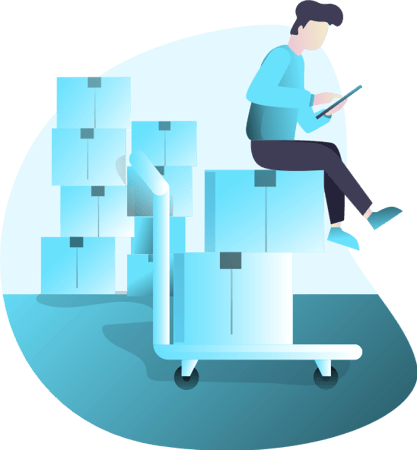
Source: Mark Quadros
The omnichannel supply chain is here to make your life easier. When using this solution, you have the option to integrate your supply chain platforms by establishing a sophisticated IT-system that oversees stock, product status, orders placed, and more. This system usually comes in the form of a warehouse management system (WMS) or an inventory management system (IMS).
Inventory planning does not start with inventory; it starts with space. As in warehouse space. The best way to handle this in an omnichannel supply chain is by merging warehouse space (or fulfillment operations) so that they serve both in-store and e-commerce business units. This translates to both physical reorganization and integration of IT processes.
In other words, your warehouse management system should now be able to handle web-based orders. It’s a tall order and far-removed from traditional processes, but it’s a must-have for effective omnichannel implementation. In the long run, you will not be able to imagine that you ever did this differently.
Inventory optimization works best when supported by sales and operations planning and demand-sensing tools with next-generation forecasting abilities.
Order management has just gotten trickier. About 30% of online orders are returned, compare this to just 9% of in-store purchases. Sixty-two percent of surveyed users said that they’re more likely to order online when they can return the item in-store.
So how do you tackle this? You need to run a tight ship when it comes to reverse logistics. This is where an integrated IT solution (a WMS or an IMS) that oversees everything comes incredibly handy.
Dan Virgillito explains it best:
“The idea is to have crystal-clear inventory visibility across all channels, which you can use as a forecaster of future product demand. And when order management and fulfillment operations are synced up in real-time across channels, each order can automatically trigger the closest distribution center and the most efficient in-house or third-party fulfillment entity.”
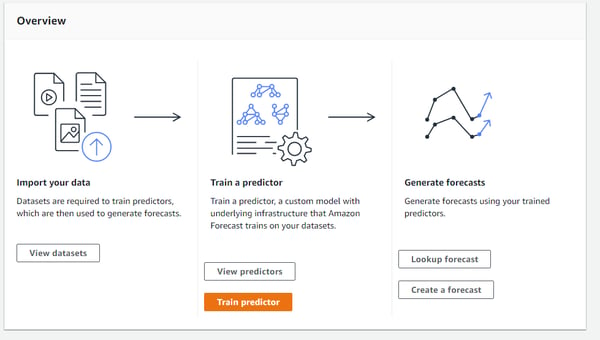
With so many channels set up for orders in an omnichannel supply chain, stock replenishment becomes less of a straightforward exercise.
A multi-echelon (multiple-tier) inventory optimization can help you with this because it focuses on inventory levels throughout the entire network. In practice, this means unifying your company’s facilities, labor, and inventory into one location (think: IKEA) or aligning all processes for each stage of the replenishment operations (think: WMS or IMS).
There are myriad omnichannel platforms that do a great job of bringing all retail supply management under one umbrella.How do you know which one is the best omnichannel platform?
We've learned that:
Establishing an omnichannel supply chain is a hard, albeit necessary step for retailers who want to stay afloat in this increasingly digital world. Even if you can’t switch right away, start making plans for the transition; the longer you wait, the more obsolete your current systems will become.
While strategizing, don’t lose sight of the most important element, the whole reason why you’re doing this: your customer. Keep it simple, make them feel valued, and the rest will follow.
Now that you're well-informed on all things omnichannel, discover the right omnichannel platform for your company's unique needs.
Mark Quadros is a digital consultant that helps SaaS brands implement sales enablement strategies using content. On another note, Mark is an excellent networker and has helped his clientele land strategic partnerships. On the personal front, Mark loves writing and contributes to several authoritative blogs like HubSpot Sales, CoSchedule, and Foundr.
Decoding the retail puzzle for businesses.
 by Téa Liarokapi
by Téa Liarokapi
The most overlooked part of manufacturing is the most important when it comes to supply chain...
 by Matthew Wright
by Matthew Wright
Is your supplier network skewed?
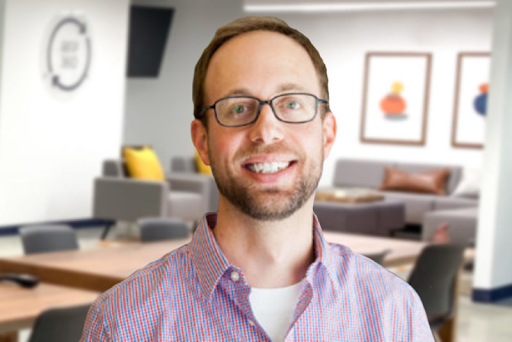 by Dave Hulsen
by Dave Hulsen
Decoding the retail puzzle for businesses.
 by Téa Liarokapi
by Téa Liarokapi
The most overlooked part of manufacturing is the most important when it comes to supply chain...
 by Matthew Wright
by Matthew Wright


